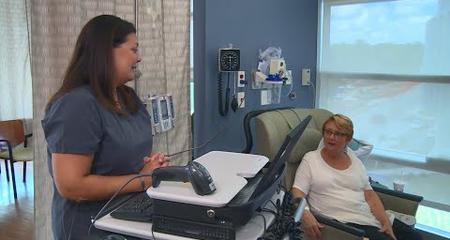Surgery is often a first-line treatment for head and neck cancer. Traditional “open” and minimally invasive surgical approaches can be effective in treating head and neck cancers. Our head and neck surgical oncology and reconstruction specialists offer every surgical option available. Our surgeons have specialized training and expertise in head and neck cancer care, are fellowship-trained and focus their practices entirely on head and neck surgery.
To provide the best possible results, our surgeons work within a team-based system, drawing on the expertise of multiple surgeon specialists when needed. Working together, our team offers more effective options when complex surgery is required. Most commonly, this involves complex reconstructive procedures, that help lead to improved functional and cosmetic results for our patients after surgery to remove a tumor.
Minimally Invasive Surgery
Whenever possible, our surgeons offer minimally invasive techniques using smaller incisions and specialized instruments to remove head and neck tumors. Minimally invasive procedures can lead to shorter recovery times, less pain, fewer complications and better outcomes for many patients. Our surgeons are experts in minimally invasive procedures while also having experience with larger, “open” procedures, so that appropriate options may be offered to our patients.
In many cases, surgery is performed through natural orifices (the mouth or nose) using endoscopes (long, thin tubes with special lighting and lenses). These tools allow the surgeon to visualize tumors and tissues inside the body so that no external incision is needed and no visible scars are created.
For many of these procedures, surgeons use additional state-of-the-art instruments, as well as microscopes, lasers, robots and other advanced technology to help eliminate cancerous cells while minimizing the disruption of normal surrounding tissues.
Transoral Robotic Surgery (TORS)
TORS is a minimally invasive way to perform surgery for cancer (or benign tumors) of the oropharynx, the larynx and base of the tongue — areas in the back of throat. Robotic technology provides surgeons with a clear, sharp view of what they’re operating on. This allows them to operate with precision and control in areas that are difficult to access with traditional open surgery. In addition to completely removing tumors, TORS can be used to diagnose cancer.
Open surgery in the back of the throat requires a mandibular osteotomy — surgery that involves moving the lower jawbone. Patients also need a tracheostomy (typically temporary) for open surgery, but it’s usually not needed for TORS. A tracheostomy is an incision in the windpipe that provides an air passage for breathing.
What to Expect
To determine if you can have TORS, your surgeon may see you in the clinic but most patients need an endoscopy to pin down the stage and extent of their cancer first. TORS might not be the best choice if you have an extensive or advanced cancer, a very small mouth or airway problems that could make the surgery risky for you. If TORS isn’t the best choice, your surgeon and head and neck cancer team will explain other treatment options that will give you the best possible outcome.
TORS Recovery
Because TORS is minimally invasive, there is less bleeding during surgery, reduced need for blood transfusion, less visible scarring and a lower risk of infection. Other benefits include a shorter hospital stay (typically, a few days), fewer side effects with swallowing, as well as faster and easier recovery and less pain. At home, you will watch for bleeding or signs of infection like a fever, and notify your surgeon immediately if you experience these issues. You’ll need to take it easy for a couple weeks, eat easy-to-swallow foods and take medication for pain. You can return to routine activities in about two weeks.
Expertise
Our head and neck cancer surgeons have received extensive training and are highly skilled in the use of TORS. They use it to treat eligible patients with the following types of head and neck cancers:
- Base of tongue cancer
- Head and neck cancer
- Hypopharyngeal cancer
- Larynx cancer
- Larynx - benign tumors
- Larynx - carcinoid tumors
- Larynx squamous cell carcinoma
- Oropharynx cancer/tumors
- Oropharynx mucoepidermoid carcinoma
- Oropharynx squamous cell carcinoma
- Parapharyngeal space tumors
- Pharynx tumors
- Pyriform sinus cancer
- Retropharyngeal thyroid cancer metastases
- Supraglottic tumors
- Tongue base squamous cell carcinoma
- Tonsil cancer
- Tonsil squamous cell carcinoma
- Vallecular cyst
Transoral Laser Microsurgery (TLM)
Transoral laser microsurgery (TLM) is another minimally invasive surgical technique that our highly trained surgeons use in appropriate situations. The procedure is similar to TORS and aims to preserve surrounding normal tissues as much as possible to help retain a patient’s swallowing and speech functions, while still allowing the surgeon to effectively treat a patient’s tumor. With TLM, a highly specialized carbon dioxide (CO2) laser beam/fiber is used instead of a scalpel to cut through tissues. This limits damage to normal structures around the tumor, such as important nerves, blood vessels and muscles that are important for a patient’s post-operative function.
Endoscopic Skull Base Surgery
The skull base is a anatomically complex and highly specialized region deep within the cranium and includes vital structures of the head and central nervous system. Our multidisciplinary team of highly-skilled specialists in rhinology/skull base surgery, head and neck cancer surgery and neurosurgery work together to provide the most advanced level of care for patients with tumors of the skull base. Treatment for tumors of the skull base may involve surgery, radiation therapy, chemotherapy or a combination of these.
For many patients, a more conventional “open” surgical approach may provide more advantages and be required. For others, a minimally invasive or “endoscopic” approach can be offered. Our surgical team is highly trained and specialized and offers both approaches to our patients, ensuring the most effective option is available to every patient.
In endoscopic skull base surgery, tumors are often accessed through the patient’s nose, sinuses or ears, sometimes allowing for incision-less surgery. Similar to other minimally invasive approaches, these procedures may allow for reduced recovery times, shorter hospital stays and fewer side effects.
Monitoring Prevents Tissue Damage
Head and neck cancer surgeons at Froedtert Hospital use special, precautionary techniques to help prevent injury to vocal cords, facial nerves and other key structures.
- Intraoperative nerve integrity monitoring (NIM), used during thyroid cancer surgery, places a special tube in the throat to continuously monitor the nerves to the vocal cords and avoid injury.
- Continuous facial nerve monitoring is used during certain procedures on tumors of the parotid gland, ear or skull base. Continuous facial nerve monitoring uses electrodes to monitor the nerve that moves the muscles in the face. The surgeon is alerted if there is any stretch or stimulation on that facial nerve, providing another safety measure to avoid facial nerve paralysis as a result of surgery.
Head and Neck Cancer Surgery - Video FAQ
Becky Massey, MD, head and neck surgical oncologist, describes head and neck cancer surgery.
During head and neck cancer surgery, patients are asleep under a general anesthesia. Our team of specialized nurses and surgeons work together to remove the tumor and do reconstruction at the same time. This allows patients to have a shorter surgery with better outcomes for speech and swallowing after they have healed.
Becky Massey, MD, head and neck surgical oncologist, explains that head and neck cancer surgery can be difficult for patients.
Head and neck cancer surgery is a difficult surgery for many patients. We understand that the surgeries that we do are happening in an area where patients have to breathe, swallow and talk.
Patients can expect to have slow progress in the recovery of their normal functions of speaking and eating within days to weeks following their surgery.
We work together with our team of therapists to exercise the muscles of swallowing and speaking. Daily exercises that the patients then continue at home gradually improve the strength of the swallowing and speaking function with the goal of patients returning to a near normal baseline.
Becky Massey, MD, head and neck surgical oncologist, talks about the varying lengths of time needed for head and neck cancer surgery.
Head and neck cancer surgery can be a very brief surgery or a long surgery that includes complex removal of tumors and reconstruction. The length of the surgery is important because patients do better when we can decrease the time that they're under anesthesia. Our team works together to do cancer surgeries and reconstructions at the same time to improve patient outcomes.
Becky Massey, MD, head and neck surgical oncologist, explains recovery from head and neck cancer surgery can take days to weeks.
Recovery from head and neck cancer surgery can take from days to weeks. Some surgeries are smaller surgeries, and patients can return to eating and drinking within days. Other surgeries are more complex, and working together with our team of nurses and swallow therapists, patients can often return to a near normal swallow within six weeks.
Michael Stadler, MD, head and neck surgical oncologist, describes the recovery process for skin cancer surgery.
The recovery and healing period after skin cancer reconstruction varies depending on the extent and the nature of the surgery that we do.
A week or two after surgery, we bring patients back for a wound check to evaluate for proper healing and to remove stitches - if we have stitches that are not absorbable or won't go away on their own. We also remove and change any bandages.
The healing process continues over weeks and, sometimes, months. The incisions often evolve over time and takes months or up to a year. We follow patients during that time and address any issues related to cosmesis — or the visual appearance — to do everything we can to make sure those are the least visible possible for the patient.
Becky Massey, MD, head and neck surgical oncologist, describes follow-up needed after head and neck cancer surgery.
Our team follows patients after treatment to make sure the cancer is gone in a number of ways. The most important element is regular clinic visits in which we do a thorough exam of their mouth, throat and neck.
In addition, we also use a combination of CAT scans and PET scans to follow patients to make sure that the cancer has not returned.
Becky Massey, MD, head and neck surgical oncology otolaryngologist, describes neck tumor removal surgery.
Neck tumor surgery includes removal of tumors in the neck through an incision in the neck. In general, that tumor can be removed and the incision can be camouflaged in a skin crease, so patients look normal afterward.
Michael Stadler, MD, head and neck surgical oncologist, explains neck dissection, its different types, why and how it is done.
Neck dissection refers to making an incision in the neckline, usually in a natural skin crease, to gain access to the lymph nodes within the neck. A neck dissection includes removal of those lymph nodes because they are either at high risk for including microscopic cancer cells or have already been determined to have cancer cells within them.
There are various types of neck dissections, and we have evolved over time with what we have learned and data. Previously, a radical neck dissection was a very extensive procedure, including not only the removal of lymph nodes in the neck, but other structures such as muscles and nerves. Thankfully, that type of neck dissection is uncommon these days, and we are able to remove the lymph nodes while preserving those other very critical structures.
Michael Stadler, MD, head and neck surgical oncologist, explains when a patient needs a neck dissection.
A neck dissection, or removal of those lymph nodes in the neck, is needed when there is sufficient risk related to cancer being in those lymph nodes, which we may or may not be able to detect with our current diagnostic imaging or pathologic evaluation strategies.
A neck dissection is needed when a patient has cancer related to the head and neck that has a risk or has already been shown to have spread to lymph nodes in the neck. When planning a neck dissection, depending on where the cancer of the head and neck is located, we have learned over time which lymph nodes in certain areas of the neck need to be removed and treated. Sometimes that includes a very limited area of the neck under the jawline and upper neck, and sometimes it includes the neck lymph nodes from the skull base or area of the jaw all the way down to the clavicle or collarbone.
Michael Stadler, MD, head and neck surgical oncologist, talks about possible side effects from neck dissection.
Side effects related to a neck dissection include numbness of the skin — which usually improves over weeks and sometimes months after the procedure. There is also potential risk to other nerves that control movement of your tongue or your shoulder. These are less common. Other side effects include the potential risk of bleeding, which is also rare.
There can be an impact on the range of motion of one's head and neck region after a neck dissection, but with the appropriate physical therapy and care and attention, those side effects can often be avoided.
Michael Stadler, MD, head and neck surgical oncologist, explains that neck dissection recovery includes different stages over a period of time.
Recovering from a neck dissection usually occurs over a period of time, with different stages of recovery. Initially, the immediate side effects related to numbness, sometimes the swelling and decreased range of motion. These side effects sometimes last weeks, but can be limited with therapies.
Long-term side effects are rare with the types of neck dissections that we do today, but sometimes require some additional therapy and attention over the weeks to months following surgery.
Virtual Visits Are Available
Safe and convenient virtual visits by video let you get the care you need via a mobile device, tablet or computer wherever you are. We’ll gather your medical records for you and get our experts’ input so we can offer treatment options without an in-person visit. To schedule a virtual visit, call 1-866-680-0505.
Recognized as High Performing by U.S. News & World Report
Froedtert Hospital is recognized by U.S. News & World Report as high performing in three adult specialties and 16 procedures and conditions, including cancer.




